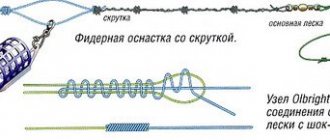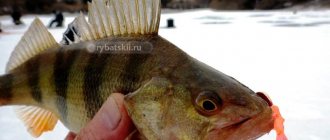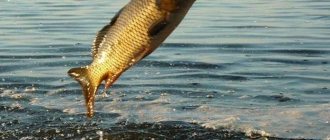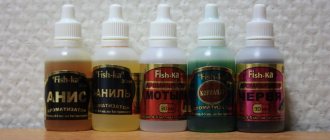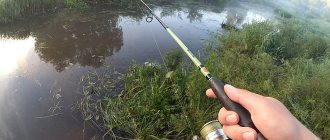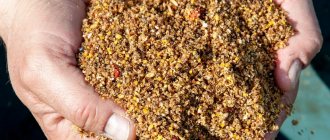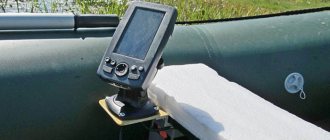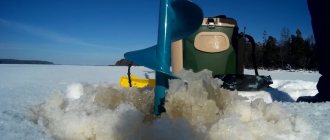Catching catfish at any time of the year is a real challenge, because catching this fish requires remarkable skill, experience and a certain amount of knowledge. If you have these qualities, then you will very soon fall into your hands. However, it is better to catch it not with your hands, but with bottom tackle, because this is the most effective and reliable way. It is better to put aside even the universal spinning rod in many ways. In the article we will cover the topic of catching catfish in the spring with a bottom and a hook, namely, how to catch catfish from the shore and boat, what to use as bait and, of course, how to make bottom equipment with your own hands.
Types of bottom gear
Bottom tackle or donka is a type of fishing tackle, which is a combination of a feeder (line and sinker) and the hook itself. This design is attached to a fishing rod, or maybe without it, and is thrown into the water for a while. The sinker lowers the feeder and hook to the bottom, attracting fish. After the donk is retrieved, the catch is removed and you can cast again. On the market and in use by fishermen, you can find two types of bottom gear:
- With a rod;
- Without a rod (snack);
- Feeder tackle.
There are a number of differences between these types, both in structure and in practical application. Which type is more convenient to use is decided by each fisherman individually. Below we will look at each type in more detail.
With a rod
Black Cat Passion Pro DX Boat.
Rod length 2.5 meters, test 400+ grams. Ideal for catfish First, let's look at the donkey version with a rod, a more common type among fishermen. Taking into account the specific design and characteristics of the desired prey (catfish), it is worth taking care of a strong and reliable fishing rod that will not let you down at the most important moment. The best option is considered to be professional equipment used by sailors, we are talking about carp or sea “sticks”.
The material of the rod must be strong and reliable, so you need to choose from carbon fiber with Kevlar and composite material, you can, of course, take a more budget option, pure carbon fiber and fiberglass, then in this case there is no guarantee that the rod will not let you down. If you want to achieve results without fear for the condition of the rod, you need to take the first two options, because the catfish will not give up without a fight.
Flagman Big Cat 8000 is suitable for catching medium catfish. Size 8000. Line capacity 0.5, 200 meters.
As for the reel , it’s a matter of taste; the main criterion is strength and reliability. But with the fishing line you already need to follow a certain rule, because the correct choice of it is influenced by the size of the catfish that can be caught. The recommended thickness is 0.5-1.5 mm; for larger specimens (for trophy fishing) it is worth taking braid with a diameter of 0.5-0.8 mm. The optimal thickness for a flood can vary from 0.1 to 0.15 mm (the number indicates how much smaller the leader should be than the main line).
Selecting a sinker is also an important and serious process; you won’t be able to tie the first stone you come across and throw the bottom into the river. The load must have a streamlined, sliding shape in order to perform only the function of a load, and not be an obstacle when catching catfish. The weight of the load depends on the depth of the reservoir; there is no universal weight. If fishing is carried out at shallow depths, then you can get by with 100-200 g, but you also need to take into account the strength of the current and the presence of keys so that the load does not get carried away. If at the place where the donkey is thrown there is a large hole, a favorite place for catfish, then a heavy load is needed, from 0.8 to 1 kg.
To catch catfish, you will need hooks . Often live bait is placed on a pair of such hooks at once, with one piercing the back behind the fin, and the other piercing the area of the anterior ventral fins. The risk of fish escape in such cases will be greatly reduced.
Without a rod (snack)
Classic casting for catfish
Under certain conditions, you can use bottom tackle without the usual fishing rod. These conditions are determined by the close proximity to the catfish habitat. Such tackle is popularly called “zakidushnaya”, based on the principle of action. This method is considered less sporty, but this is all a matter of taste, so only the fisherman can decide how he will catch his catfish.
If fishing takes place from the shore, then the donka needs to be tied to a tree branch, bush or a stake specially driven into the ground. It is worth understanding that the reliability of the fastening will determine whether the catfish will be yours or will continue to plow the pond. If a boat is used for fishing, then the fisherman needs to keep the tackle. In this case, instead of the main fishing line, you need to use a nylon cord, for obvious reasons (the fishing line is very difficult to hold in your hands, and it is dangerous). It would be a mistake to tie the donkey to a boat or to a part of the body.
In the case of a boat, damage to the part to which the donk is attached is possible, and as for a person, this fastening can lead to a dislocated limb. The strength of a large catfish is quite enough to cause significant harm, so it is better to escape from your hands than to cause harm to the boat or health.
Fishing methods
To catch catfish in the spring, powerful gear is used. You shouldn’t count on the fact that the fish has weakened after hibernation. Current methods of catching a “mustachioed” predator:
- for bottom tackle. For fishing from a boat in the current, this is the best option. The donkey rig is quite simple: a sinker is attached to the end of the fishing line. The mass of the latter is selected taking into account the characteristics of the current: on a weak flow, products of 40–50 g are used, on a strong one, up to 100 g. A pair of leashes with hooks are attached above. The latter should not touch the sinker. The fisherman, holding the fishing line tightly in his hands, can make minimal lifts of the equipment to attract the attention of the predator. What’s interesting: you can catch catfish using a “donka” both at the beginning of the bite from a boat and during the pre-spawning feast from the shore. That is, this is a universal tackle. To catch a “mustached” predator from the shore, a “donka” with a rod and a reel is used, or, in other words, a “throwaway”, especially if a thick braided cord is used;
- for spinning. This tackle is suitable for catching catfish only from the shore. The choice of rod should be made based on personal preferences regarding wiring technology. But in any case, the spinning rod must have strength characteristics. A rigid rod is chosen for the equipment, since heavy baits are used. Preference should be given to braided fishing line, since it is characterized by high strength and will ensure the sensitivity of the gear. It is better to choose a power coil. Fish are caught using spoons and jigs. A carp inertia-free model is suitable for casting heavy baits from the shore;
- on kwok. It is a device consisting of a handle, a snout and a leg, which, when struck on the surface of the water, produces a characteristic sound that attracts the attention of the fish. Catching catfish with a quok must be done from a boat. Since the plan is to hunt for a large animal, the gear chosen is quite powerful;
- on a wobbler or, in other words, on trolling. This method assumes the presence of a moving watercraft. The rods are attached very tightly to the boat, since the hunt is for a large trophy. On each tackle there is only one bait, which moves behind the boat. The predator will not chase the rapidly flying bait. The best result will be provided by a wobbler that will move at low speed and gradually cling to the bottom, creating additional noise. After all, catfish hear and feel the vibrations of water well. You can catch the predator by trolling from the beginning of April to the end of October.
To increase the fish catch, it is recommended to increase the sensitivity of the gear, use a bite activator and pheromone-based bait.
When and where to catch catfish in spring
Traditionally, spring is the best time for fishing, both for catfish and any other fish, because the aquatic world is just waking up from winter icing, the water rapids are diverging. And some types of fish begin seasonal migration and spawning. I worry the least about other fish now, all eyes are on the ruler of the reservoirs, the catfish. The most suitable time for fishing is considered to be in the morning , when the sun is just rising, it all depends on the month, but it is recommended to start at 4-5 o’clock.
For those who do not like early rises, it is possible to go in the afternoon, when the sun warms up the water well. The best time is considered to be when it begins to get dark, because catfish are hunters, and they begin to hunt most actively closer to night. If in the morning you should look for catfish in river holes, then in the evening he tries to stay closer to the shore in order to catch his prey.
Deep and dark holes are considered the usual habitat for catfish , but if there are a lot of them in the river, then it obviously won’t be found in every one.
In such a situation, you can try to find it in each one, but if we are talking about large rivers, then a season may pass until all the holes are tested. You shouldn’t rely on blind luck in this matter, so here are a number of tips to quickly and efficiently determine the habitat of catfish:
- You need to look for the deepest and darkest places .
- Catfish love hard and clay bottom .
- Catfish will give preference to a house with “interior decoration”, so you are looking for old koryaks , fragments of trees , and so on.
- Catfish are very rarely located in areas with abundant vegetation, so this is excluded.
These tips are by no means universal for all bodies of water, but they will help save time on searching, so it’s worth listening to them. If you find a suitable place, but there are no catfish there, then there is no need to despair, you should try at another time of the day (if you caught it in the morning, then come in the evening). The fact is that catfish can change several places in a day, which is why they are considered so elusive.
Video on catching catfish on a donk in the spring:
Behavior in early spring (March, April)
Early spring is a good time to open the fishing season and, at the same time, hunt for catfish. But this period (from March to early April) has a number of disadvantages. The most important thing is that when the water warms up, catfish begin their active hunting, which means that wintering aggregations break up into small groups. With such compositions, they begin to plow the reservoir in search of food, which makes them more difficult to detect. The second disadvantage is not strongly related to fish, but concerns the situation on the surface of the water. Melting ice, and in some regions very slowly, interferes with fishing, which is why most fishermen prefer to wait until the second half of April to thoroughly begin catching catfish that have already calmed down.
Catfish behavior in May
In winter, catfish fall into deep hibernation, and with the first rays of the spring sun they begin to wake up.
The awakening is by no means gradual; as soon as the ice crust melts off and the water begins to warm up normally, the activity of the catfish increases sharply. Their large groups break up, and everyone looks for their own prey, but by the end of April their activity decreases, and the regime begins to take on a measured pace. And just in May, the ideal time comes to spend your time catching catfish, and not searching for its habitat. In May, catfish behave relatively calmly, especially in the morning and in the first half of the day, when the water is just warming up.
At this time, you need to look for it in holes, snags, and so on. But closer to night, when the water warms up well, the catfish becomes more active. You should no longer look in the usual pits, but pay attention to the habitats of the small fish on which it feeds. Of course, it becomes more difficult to find the place, but thanks to the increased activity, the chance of a bite also increases.
When it bites: daily and weather patterns
Catfish activity in spring depends primarily on water temperature . Therefore, a mandatory tool for a fisherman, especially in the first spring months, should be an ordinary thermometer. Although the water temperature at the surface and at depth may differ, an approximate position on the state of affairs in the reservoir can be obtained. If the water temperature does not exceed +8 degrees, then catching catfish is pointless.
However, the water temperature may change during the day. Warming up the water during the day can cause the catfish to start feeding, and this moment should not be missed. At night, the water temperature is always lower than during the day, and therefore, in the spring, night fishing for catfish is not practiced. This, of course, does not apply to warm days at the end of May, when the catfish switches to its summer feeding mode.
Catfish can bite in any weather, but warm days are more successful than cold ones, and when it gets very cold, the bite can stop completely .
Expert opinion
Knipovich Nikolai Mikhailovich
Zoologist, hydrobiologist. I am interested in fishing at a professional level.
Unlike many fish, the activity of catfish can increase with sudden changes in atmospheric pressure. Therefore, with the approach of a thunderstorm front, you need to be prepared for a good bite.
Catfish can be caught well in both clear and cloudy weather, if the combination of other factors at this time is favorable.
What to use as bait and lures
Chopped shellfish meat is the favorite food of catfish in spring.
Preparation is a very serious process of catching catfish, and the selection of bait determines 50% of all success. By nature, catfish fish are picky and indiscriminate, so they can fall for almost anything. But in the spring, after hibernation, catfish have a lot of food, so you need to choose a competitive bait that will definitely attract fish to you. Therefore, as bait, use:
- Large insects (mole cricket, locust);
- Small fish;
- Pieces of meat (freshness does not matter);
- Shellfish (mussels, snails);
- Small animals (frogs, mice);
- Worms.
The size of the bait determines the size of the prey, so to catch particularly large specimens, it is worth using the appropriate bait, namely mice, frogs, and so on. For small catfish, worms and insects are also suitable, but you will need a lot of them.
In addition to other baits, frogs and grasshoppers are also suitable.
Fishing places
Catfish begin to bite in the spring when the water temperature reaches about 10 degrees. Depending on the region and how early spring will be, this period may fall in any month.
At first, the fish will still stick to their winter camps. After warming, it comes out to the shallows, where it can be caught throughout the day, being especially active in the afternoon. Although it is worth noting that in spring the behavior of catfish is very unstable, which is primarily influenced by the changeable weather at this time of year. Periodically, bursts of its activity occur during warm rains.
In addition to the shallows, you should definitely explore the following places:
- Channel edges
- Areas of depth differences
- River fairway
- Pits, on one side of which there is access to shallow water, and on the other, access to the riverbed
- Areas of rubble of trees and shrubs near the depths
- Behind the dams downstream
But in places with muddy water and a silted bottom, you shouldn’t look for catfish.
River floodplains
Most shallow water areas are flooded during spring floods; many fish go there to feed or spawn. The catfish will not miss this opportunity and will definitely follow its prey.
In this case, small catfish will go after the fish, and a large predator will set up ambushes at the entrances to the formed temporary channels.
oxbow lakes
Lateral tributaries of large rivers with weak currents will become suitable places for catfish to stop and feed. They will be especially promising when the fish go to spawn. Considering that such areas do not have a large area, they can be easily examined with a spinning rod.
Lakes
Lakes, especially large ones, are suitable bodies of water for catfish, providing them with both shelter and food. Most often, the predator stays among aquatic thickets. Therefore, you can provoke him to attack by placing the bait at the very border of vegetation and open water.
Bottom rig for catfish
As mentioned above, the structure of bottom gear is quite simple. But simplicity is where the main advantage lies. If you disassemble the donk into parts, the structure will consist of:
- Sinker;
- Feeder (in the manufacture of feeder equipment);
- Hook;
- Retractable leash;
- Fishing line.
This design can be attached to a fishing rod or to a rope, depending on personal preference. Particular attention should be paid to the quality of each part, because if a low-quality part is used, the entire tackle becomes ineffective. Given the simplicity of the design, you can assemble it yourself; below we will tell you how.
Snack: tackle
Fishing from the shore using a donk with a rod
Paternoster variant without feeder
How to make it yourself
To make a donk yourself you will need a strong fishing line 0.5-1 mm in diameter. The number of hooks has no restrictions, only in terms of weight, so that the structure is not too heavy, otherwise the hooks will fall to the bottom and be completely ineffective. We recommend choosing hook sizes from 10 to 40 and the appropriate weight for them. The distance between the main load and the leash should be at least 30-50 cm. The big advantage of a homemade design is its low cost and the ability to make it strong enough to catch particularly large prey.
Variant of paternoster with twisting. This gear is suitable for more targeted feeding
Catfish fishing time
Catfish is a very predictable fish in terms of timing for fishing. If you're keen to catch this massive predator, consider factors such as time of year, water temperature and time of day. We will talk about the main guidelines below.
So, experienced catfishers identify two main periods when the catfish becomes especially active and feeds a lot. The first of these is the relatively short period before spawning, which is also called the period of functional zhora. At this time, catfish bite well on virtually any type of bait. The pre-spawning period occurs from the end of April until the start of spawning. Spawning begins when the water temperature reaches 18-20°.
A longer period of catfish activity begins after spawning, already in the summer season. From approximately mid-June until the end of September, the second phase of active feeding of this predator continues. The peak falls in August.
Regarding the daily time, it is worth saying that it is best to catch catfish at night in good weather or early in the morning from 4 to 6-7 o’clock. During the daytime, biting is unlikely and occurs most often only in cases where the bait falls right under the catfish’s nose.
Cold weather at any time of the year negatively affects the number of bites, since in such conditions the catfish sinks into deep underwater holes and very rarely makes night and morning swims in search of food.
Catfish fishing (video)
| Spinning rod rigs (Texas, Carolina, dropshot) | Fishing knots and leashes, knot strength | How to disassemble and lubricate the reel |
| Fishing with jerkbaits | Fishing with surface baits (gliders) | Propbait fishing (lure with a propeller) |
| How to choose a popper, what to look for when choosing | Devon fishing (unique spinner with a propeller) | Do-it-yourself spinnerbait (making and fishing) |
fisher-book.ru
Techniques and features of catching spring catfish on a donk
The fishing technique itself is quite simple, the difficulty lies only in the fish and its behavioral characteristics and habitat. By their nature, catfish are very unpredictable and cunning, so they choose places that are problematic for fishing and are active only at night, when fishing is extremely inconvenient. Here is a list of actions you need to take to increase your chances of success:
- Prepare all the appropriate gear and equip the workplace. If this is the shore, then it is convenient and secure to fasten the rod or rope. The bite time can be very different, some will be lucky to catch it in 5 minutes, while others will spend half a day, so take care of the fishing chair. It should be comfortable and stand steadily close to the donkey; the closer, the faster you can react.
- When all the equipment is ready, you need to choose a location. Habitats and tips for finding a place were described above in the section “When to catch catfish in the spring.” Follow these rules and the likelihood of success will be much higher.
- Catching catfish can take a very long time, but the number of gear will increase your chances. Using 4 donks will be much more effective than one. But you shouldn’t put more than 5, because then it will be very difficult to keep track of everyone. Using several bottom tackles will increase the coverage area; throw 2-3 tackles into the pit itself, and 1-2 at the exit from it.
- When the bottoms are abandoned, feed the catfish to attract them to your gear.
- Then everything depends on the fisherman. It can jerk the bottom in the water, creating waves or muddying the bottom, creating the effect of swarming the fry. One way or another, you need to periodically carry out manipulations to attract hunters.
After some time, everything depends on luck and the number of individuals in the reservoir, the coveted catfish will be hooked, then you need to not miss it and, with all diligence, pull it ashore. Large specimens in large rivers can well exceed 10kg and come with corresponding strength, so be prepared for a fight.
Search for catfish sites
To catch catfish, an angler needs to look for the deepest parts of a river or reservoir using an echo sounder. The entrances and exits from them become the most catchy places. If not far from the hole there are steep banks, pools, trees and bushes bent over the water, then the catfish may appear here to feed. Before spawning, you should look for fish at a depth of 1-2 m, which is adjacent to the riverbed or hole. Bays and creeks at the beginning of summer are also promising for catching freshwater giants. The catfish rises to the surface only on clear moonlit nights, as well as during a thunderstorm. In the fall, he is one of the first to go to wintering pits.
